After two months of slow travel in Vietnam, I’ve learned a few things: the city wakes up before I do, the coffee is strong enough to knock your socks off, and it’s completely okay to skip the places everyone else is flocking to. This 2-week itinerary focuses on the north and central regions – leaving out Saigon and Ha Long Bay – because sometimes, less is more.
I made this route for travelers like me: digital nomads, mid-budget explorers, and anyone who wants to experience Vietnam without racing from one stop to the next. It’s a slower pace, but not a quiet one, you’ll still get the buzz of Hanoi, the beach days in Da Nang, and plenty of chances to dive into Vietnam’s history and food culture.
We skipped Ha Long Bay – not because it isn’t beautiful, but because it’s crowded and tightly packaged. Ninh Binh offers a similar landscape with limestone cliffs and river cruises, though it’s far from undiscovered. And as for Saigon, I gave those days to quieter places I enjoyed more, like Hue and Da Nang.
This itinerary includes practical tips for Pakistani passport holders, solo travelers, and anyone looking to plan a solid two weeks in Vietnam with a little breathing room.
How many days should you spend in Vietnam?
How long should you spend in Vietnam? It depends on how many places you want to cover and how much time you can take off. I recommend at least 14 days to fully enjoy the highlights without rushing. Spend three days in big cities like Hanoi to explore at a relaxed pace and at least two days in smaller spots like Ninh Binh.
For a first-timer, a two-week Vietnam itinerary is perfect. It’ll let you cover the major sites while still giving you breathing room to take it all in. If you have extra nights, consider adding more destinations like Sapa or Nha Trang, but for most people, two weeks is just enough.


Day 1–4: Hanoi
When I first arrived in Hanoi, I didn’t know what to make of it. The streets were chaotic, the air thick with motorbike fumes, and the constant buzz overwhelming. But somehow, it works. You start syncing with the rhythm – crossing busy intersections with instinct instead of logic, grabbing street food from corners that don’t look like restaurants.
The city is full of contrasts: colonial buildings beside crumbling alleys, street vendors outside glassy cafés, and the wreckage of a warplane half-submerged in a lake near my apartment.
Hanoi is the only place I’ve been where a 7 AM walk isn’t the calm before the storm. Locals are already doing tai chi around Hoan Kiem Lake, slurping pho on plastic stools, and going about their day like it’s noon. As a digital nomad used to quiet mornings, that took some getting used to. But after a few days, I found myself enjoying the energy.
After a month here, I still can’t claim to understand the frustrations of daily life, but the place grew on me. Its layers – colonial architecture, war relics, hidden cafés and Buddhist temples – reveal themselves slowly, once you stop trying to figure it out and just move through it.
What to Do in Hanoi
Start in the Old Quarter, but don’t bother with a plan. Just wander. Each narrow street is dedicated to a different trade – silk, spices, shoes – and the whole place hums with life. It’s chaotic, sometimes infuriating, and completely addictive. Grab a bowl of pho from a street vendor, squeeze onto one of the tiny plastic stools, and watch the city move.
By 7 AM, Hanoi is already wide awake. At Hoan Kiem Lake, locals practice tai chi under the trees while nearby cafés are already serving their first bowls of breakfast noodles. Walk a little further and you’ll find Train Street, where a passenger train barrels through a narrow alleyway, brushing past balconies and coffee cups. It’s surreal, and worth the detour – just be sure to check the train timings and what to expect at the cafés before you go.
For a break from the noise, the Temple of Literature offers a rare bit of calm. I’d skip the Ho Chi Minh Mausoleum unless you’re especially into political history, it’s imposing, but not all that engaging.
If you’re staying longer, the café scene is worth exploring beyond just a caffeine fix. I worked remotely from spots like Tranquil Books & Coffee and Xofa Cafe & Bistro – quiet corners, strong Wi-Fi, and good coffee. Cong Café makes a solid coconut coffee and has a kind of retro-war aesthetic that weirdly works. Working from cafés became one of the best ways to explore the city, each one reveals something about the neighborhood it’s in.When the Old Quarter starts to feel like too much, head toward the French Quarter. The sidewalks widen, the buildings get grander, and for a moment, the pace of the city feels a little less urgent. If you’re planning to spend a few days here, I’ve put together a 3-day Hanoi itinerary with exactly how I’d do it again.
Where To Stay In Hanoi
Where you stay in Hanoi will shape how you experience the city. Some neighborhoods drop you right into the noise; others give you breathing room. Here’s a breakdown of the areas I’d consider—and a few stays I’d book again or recommend based on my own time here.
Old Quarter – For First-Timers and Short Stays
This is the chaotic heart of Hanoi, packed with street food stalls, historic sights, and constant motion. If you’re only here for a few nights, staying in the Old Quarter puts you close to everything. You’ll be able to walk to most attractions and feel the pulse of the city from the moment you step out.
- Phen Art House | A boutique option with comfortable rooms and calm interiors, just steps from the action.
- Hanoi Secret Garden | Clean rooms at a boutique hotel in a central location. Great for budget travelers or solo backpackers.
Tay Ho (West Lake) – For Digital Nomads and Longer Stays
Tay Ho is Hanoi’s expat neighborhood. It’s quieter, leafier, and more spread out, with lakeside cafés and international restaurants. If you’re working remotely or just want a slower pace, this is where you’ll find it. It’s not as convenient for sightseeing, but Grab rides are cheap and quick.
- iRest Tayho Lakeside Apartment | Spacious rooms, great Wi-Fi, and a peaceful atmosphere.
Ba Dinh – For a Local, No-Frills Experience
This is where I stayed for a month. It’s less polished, not touristy, and English isn’t widely spoken but that’s the charm. You’ll find small markets, local eateries, and the kind of daily life that never makes it into guidebooks. It’s a good pick if you’ve been to Hanoi before or want to skip the tourist trail.
- Eco Nest | We stayed at this apartment for a month, it had a small gym on the rooftop, perfect for a longer budget stay.


Day 5–6: Ninh Binh
About Ninh Binh
A two-hour limousine bus from Hanoi dropped us into a landscape that felt transportive: limestone cliffs, winding rivers, and rice fields that looked unreal in the morning light. People call it “Ha Long Bay on land,” but Ninh Binh doesn’t need the comparison. It has its own tempo – quieter, slower, and easier to sink into.
We skipped Ha Long Bay on purpose. I wanted calm, not crowds. Tam Coc, the go-to hub, felt too curated, so we stayed in Trang An instead. Less infrastructure, more space. Our timing was everything. Sunrise hikes, the last boat out, bike rides before the tour buses rolled in. For more tips and how-tos, I’ve written a full guide to Ninh Binh.
What to Do in Ninh Binh
We climbed the steps to Hang Múa at sunrise and had the viewpoint to ourselves. The view was great, but it was the quiet trails and lotus ponds below that stuck with me. The Trang An boat ride was another highlight – golden hour, no crowds, drifting through caves and past temples without any of the pushy vendors you get in Tam Coc. We spent afternoons cycling through backroads and fields, with water buffalo grazing nearby and no real destination in mind.
Tam Coc had its moments – Chookie’s Beer Garden, international food, and general convenience. But I was glad we based ourselves elsewhere.
Where To Stay In Ninh Binh
We stayed at Green Mountain Homestay in Trang An, which felt more like a countryside resort than a homestay. Waking up there meant mountain views instead of morning traffic. It’s close to most of the major sights, with bike and scooter rentals available onsite.
If you want something livelier and more walkable, Tam Coc has plenty of restaurants, bars, and cafés. But for a quieter, more immersive experience, I’d recommend Trang An. It felt like a true break from the noise.


Day 10–12: Hue
About Hue
Hue, the former imperial capital of Vietnam, sits quietly along the Perfume River—dignified, moody, and layered with history. Once home to the Nguyễn Dynasty, it carries the weight of that past in its architecture, rhythms, and rituals. Compared to Hanoi’s chaos and Ninh Binh’s stillness, Hue feels like a midpoint – less overwhelming, but no less rich.
We didn’t stay overnight. Instead, we took a full-day trip from Da Nang, crossing the Hai Van Pass – a scenic coastal route that curves through misty hills and offers one of the most beautiful drives in the country (more on that here). If you’re after more thrill than comfort, you can book a motorbike tour. Either way, getting there is part of the experience.
What to Do in Hue
Hue’s main attraction is the Imperial City – a walled palace complex modeled after Beijing’s Forbidden City. We joined a walking tour, which offered a deep dive into the Nguyễn emperors, concubine quarters, and royal ceremonies. Honestly, it dragged a bit by the end but having a guide helped bring life to what might otherwise feel like another set of ruins.
Outside the palace walls, the Perfume River cuts through the city. We didn’t take a boat, but you can hop on one to visit Thien Mu Pagoda, a seven-story Buddhist landmark that overlooks the river. Whether you get there by water or road, it’s worth a visit—quiet, symbolic, and still a functioning temple.
Hue is also known for its imperial tombs. We visited two: Tu Duc’s, which is poetic and surrounded by pine trees and lakes, and Khai Dinh’s, which is all black stone and baroque flourishes built into a hill with dramatic views. The contrast between them is striking and tells you a lot about how Vietnam’s royal history evolved under colonial influence.If you’re staying more than a day, a motorbike tour to see the tombs and countryside is a great way to break up the history with some movement.
Where To Stay In Hue
Stay close to the Perfume River—this area is peaceful, central, and ideal for evening walks or café hopping. Below are a few top-rated options for different budgets and styles:
Luxury | Azerai La Residence – An old colonial mansion turned riverside hotel—quiet, elegant, and just far enough from the chaos.
Mid-range | Melia Vinpeal Hue – A great hotel with amazing views of the city.
Budget | Senna Hue Hotel – Affordable, clean, and central—easy walking distance to most sights without sacrificing comfort.
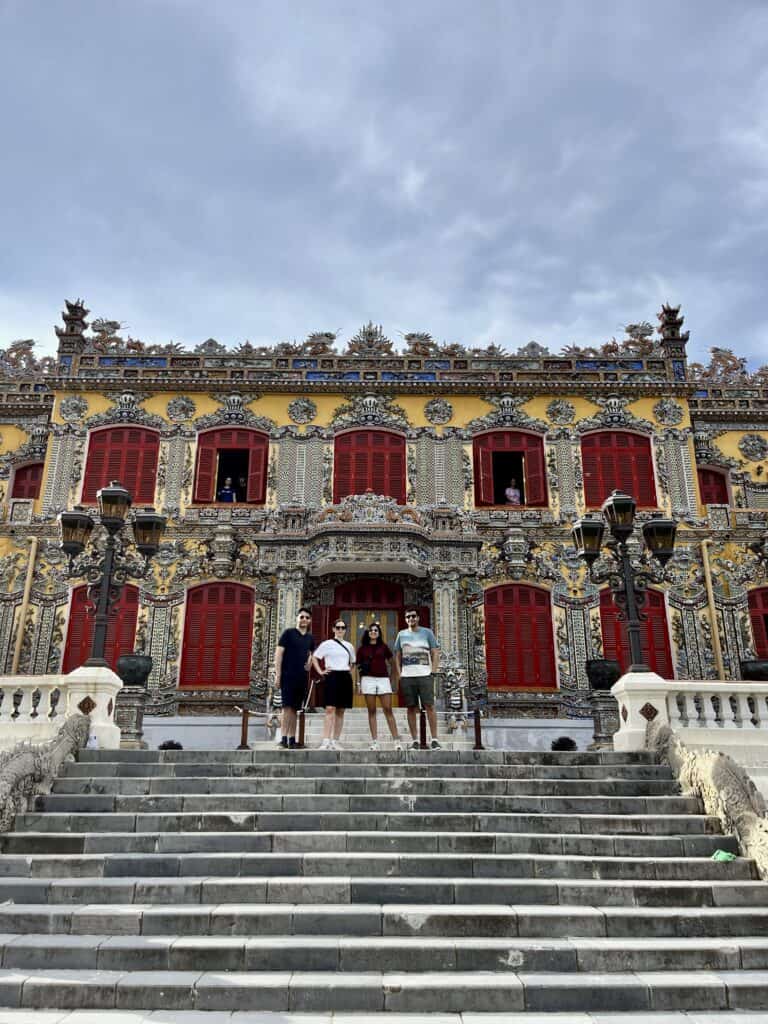
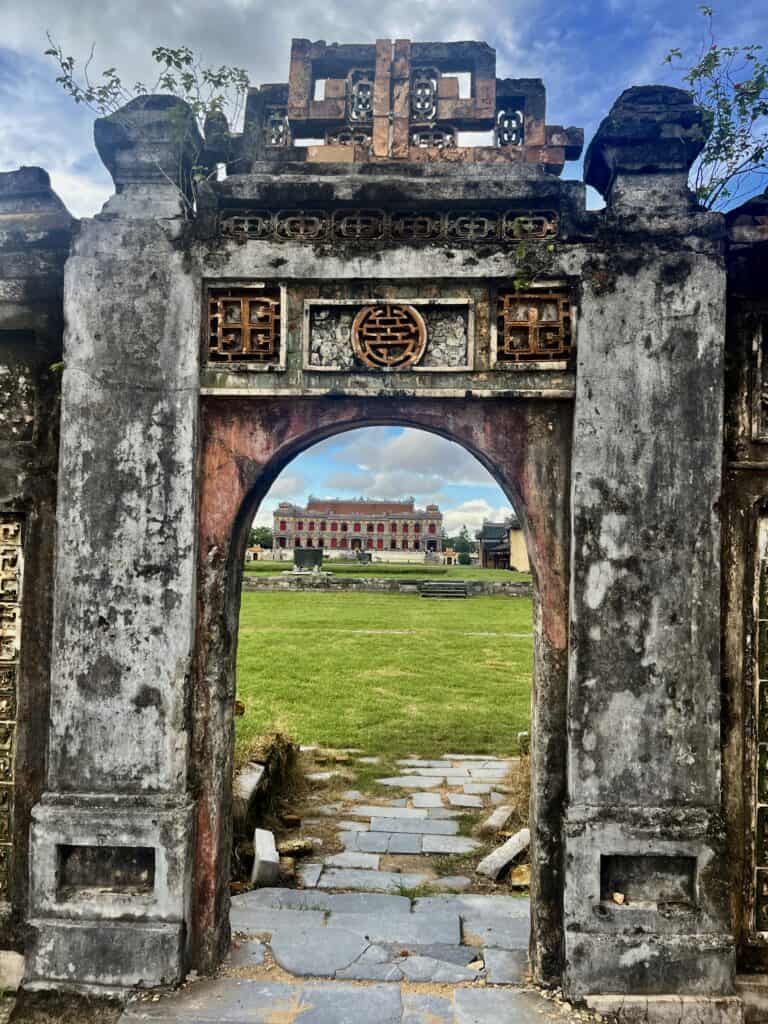
Day 13–17: Da Nang & Hoi An
About Da Nang & Hoi An
Da Nang and Hoi An are close enough to share a base, but different enough to feel like separate worlds. Only 30 – 45 minutes apart, they’re connected by smooth roads, frequent Grabs, and even bike paths if you’re feeling adventurous. Most people stay in Da Nang and day trip to Hoi An or vice versa –and that setup works beautifully.
Da Nang is Vietnam’s slow-burn beach city: early swims, salt in your hair, and coffee strong enough to jolt a jet-lagged soul awake. Hoi An, on the other hand, is all charm—lantern-lit nights, riverside cafés, and centuries-old buildings that feel plucked from a storybook.
We stayed in Da Nang but ended up shuttling between the two regularly. If you’re trying to decide between them, just know: Da Nang is better for downtime and beach days, Hoi An is better for atmosphere and old-town wanderings.
What to Do in Da Nang
Da Nang grew on me slowly. It wasn’t loud or flashy—it just worked. Mornings began with silent swims before sunrise (seriously—go before 7 AM), followed by street-side bánh mì and iced coffee strong enough to jolt you awake. Later in the day, we’d scooter up to the Marble Mountains or circle the Son Tra Peninsula, where the Lady Buddha watches over the city.
The beaches stretch for miles. My Khe is the obvious one, but if you’re looking for something quieter, head toward Non Nuoc or south of the peninsula. I’ve shared a few underrated spots and where to avoid the crowds in this post on Da Nang’s beaches.
At night, we’d end up at the Son Tra Night Market—cheap eats, live music, and the kind of sensory overload that somehow works. For a full breakdown of hidden cafés, day trips, and what’s worth skipping, here’s how I spent my time in Da Nang.
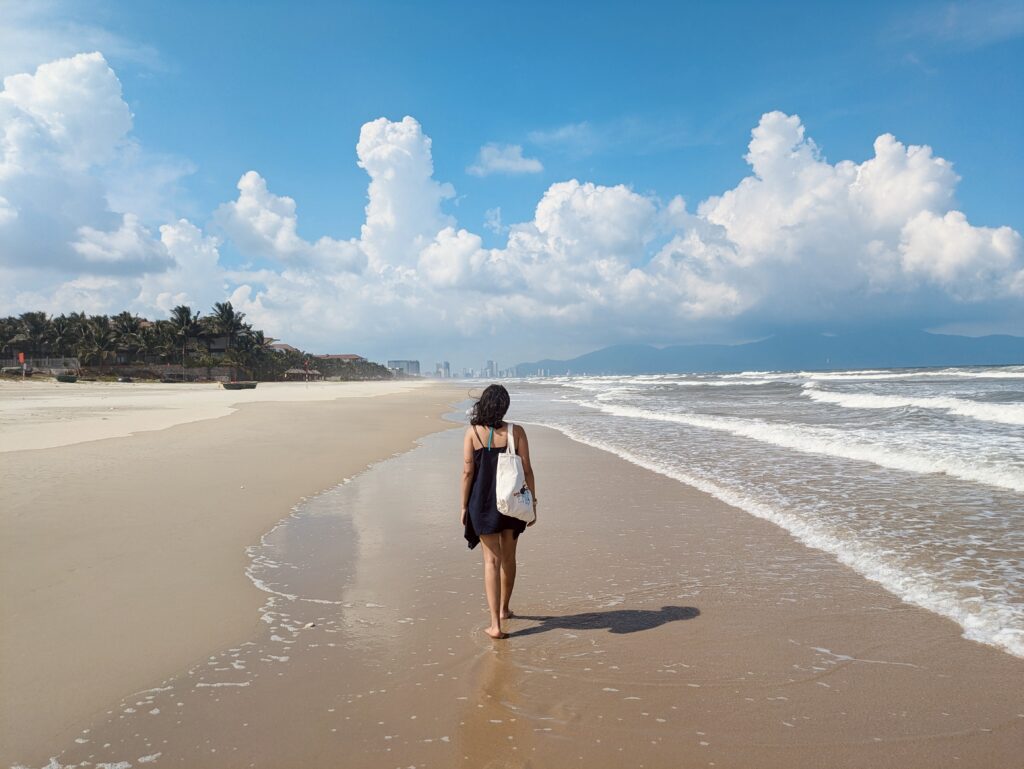
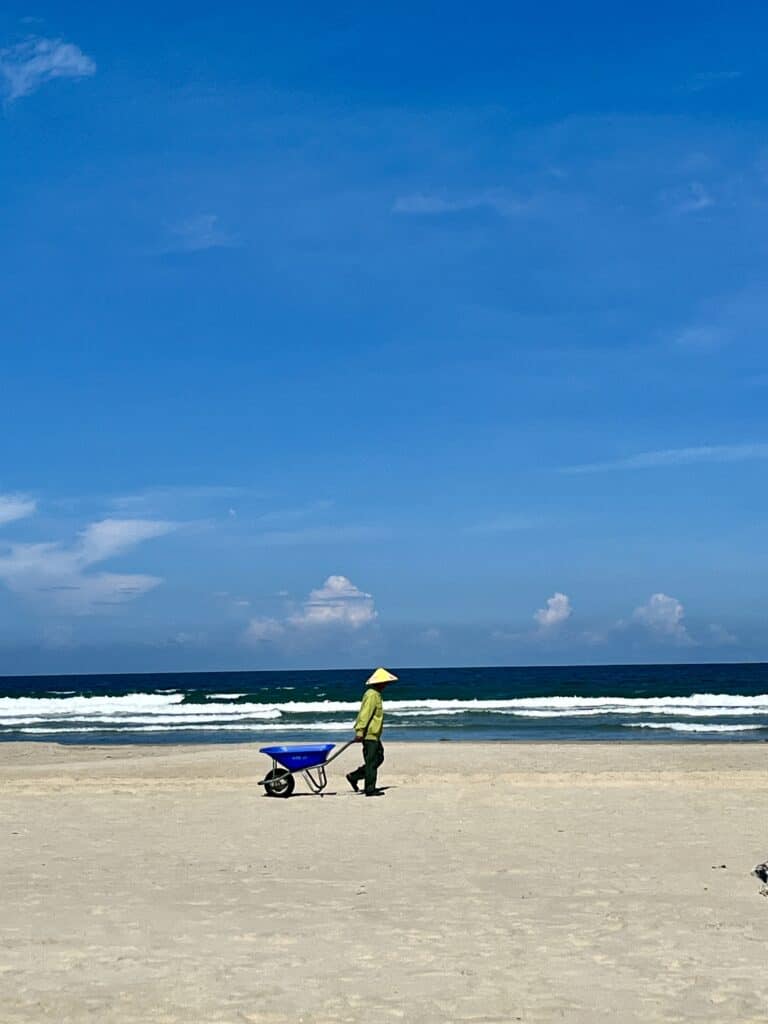
What to Do in Hoi An
Hoi An is a quick trip from Da Nang but feels like a different world. You’ll swap scooters for slow walks, streetlights for lanterns, and high-rises for centuries-old homes. The Old Town is where everyone goes and for good reason. Go in the late afternoon, stay into the evening, and if you time your visit right, you’ll catch the Lantern Festival lighting up the river. I wrote more about how to experience it without the crowds here.
Even outside the festival, Hoi An glows. Boats float down the river carrying paper lanterns, vendors sell incense and wishes, and the whole place feels like a movie set. Yes, it’s a little kitsch but in the best possible way.
There are tailors, cooking classes, beach cafés, and plenty of distractions if you want them. But for me, one slow evening in Hoi An left a stronger impression than a week in places that tried harder.
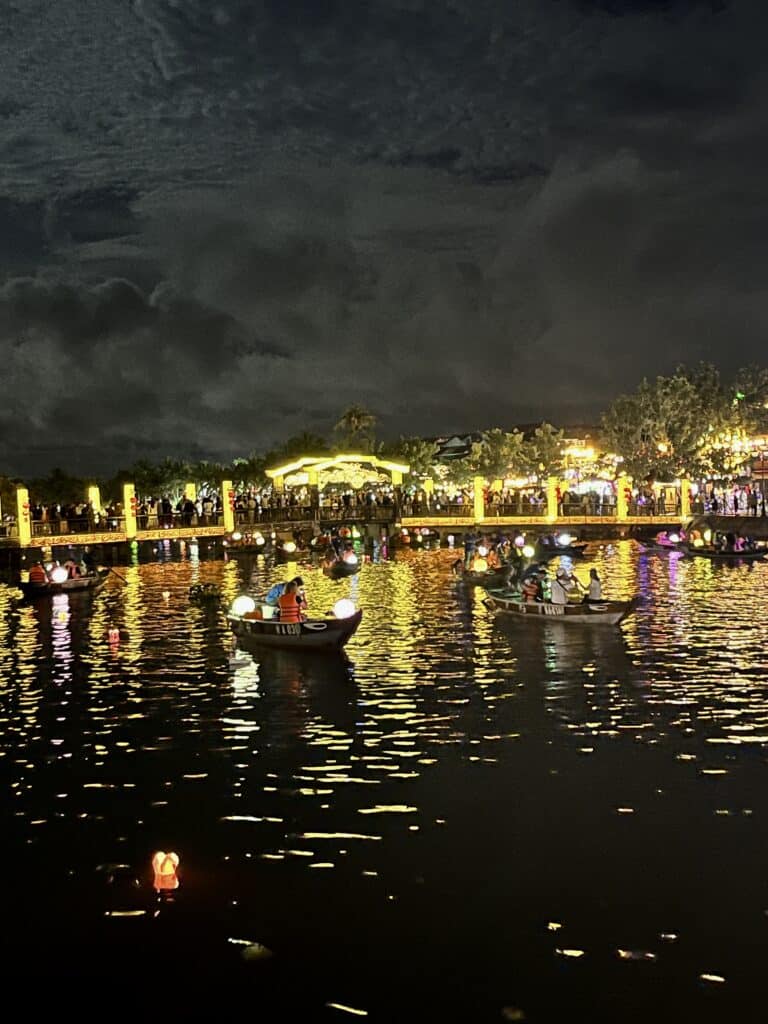
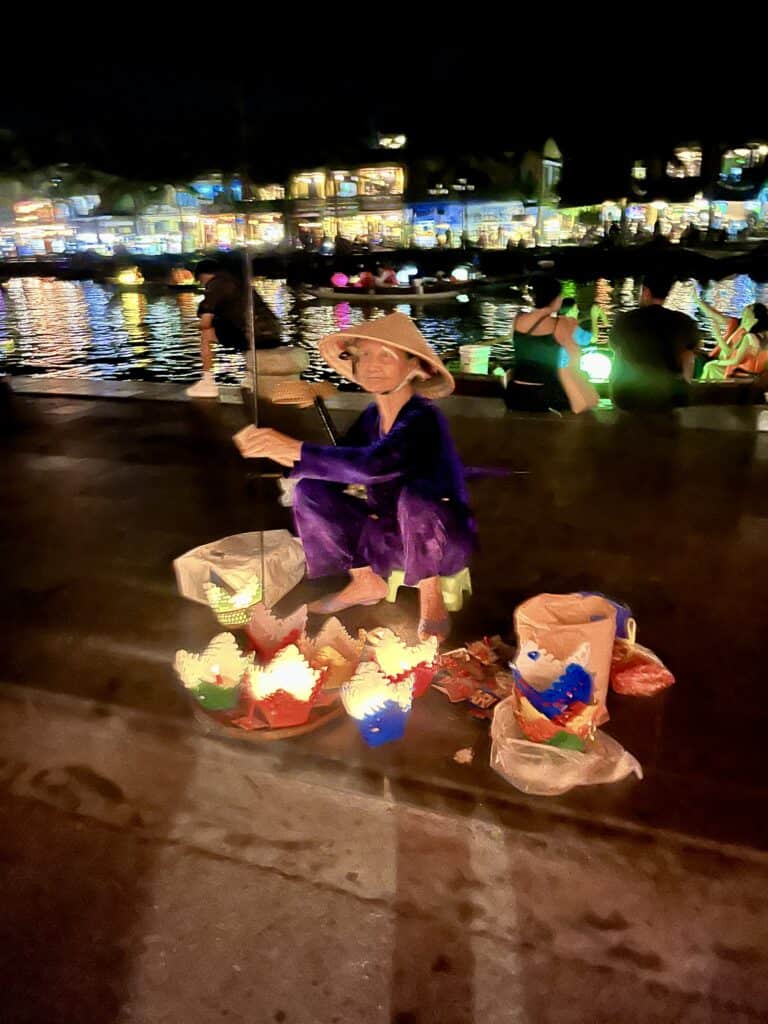
Where to Stay in Da Nang & Hoi An
Depending on your pace, you can either base yourself in one place and day trip to the other or split your time between both. Below are top-rated stays that make the most of each location:
Da Nang
Luxury | TIA Wellness Resort – A beachfront retreat with private pools and daily spa treatments, ideal if you’re in serious unwind mode.
Mid-range | HAIAN Beach Hotel & Spa – Right across from My Khe Beach with a rooftop pool and ocean views, without the resort price tag.
Hoi An
Luxury | Anantara Hoi An Resort – Colonial charm by the river, walkable to the Old Town and a peaceful escape from the crowds.
Mid-range | Little Riverside Hoi An – Boutique-style, central, and warm—perfect for a couple of slow days in the lantern-lit streets.
Additional Destinations I Wish I’d Had Time For
Sapa
Sapa is one of those places I had every intention of visiting—until Typhoon Yagi rolled in and shut down the roads. Set high in the northern mountains, it’s famous for misty terraced rice fields, cool weather, and its hill-tribe villages. I was especially excited to climb Fansipan, the tallest peak in Indochina—something my sister did years ago and never stopped talking about.
You can get there from Hanoi by sleeper train, and if you’re into trekking, this is probably the best spot in the country to do it. Just know that the main town can feel a bit touristy; nearby villages like Ta Van offer a quieter, more authentic base.
Ha Giang Loop
This is the one that got away. If I knew how to ride a motorbike confidently, the Ha Giang Loop would’ve been non-negotiable. It’s a multi-day journey through the mountains of northern Vietnam—full of sharp turns, remote villages, and jaw-dropping views. Everyone I met who did it said it was the highlight of their trip.
The route starts from Ha Giang City and takes around 4–5 days to complete. You can also book an Easy Rider tour, where a local does the driving. If raw, off-the-beaten-path travel is your thing, this is the place. I didn’t want to rush it or fake my way through it—but I’m already planning for next time.
What to Eat in Vietnam
Vietnam’s food scene is an experience in itself—fresh, vibrant, and full of surprises. If you’re only eating pho, you’re missing out.


Travel Logistics
E-Visa for Pakistani Citizens
Yes, it’s possible—and surprisingly smooth. Apply online via the official site. Processing takes around 3 working days. Just double-check your passport details before submitting.
Getting Around
GrabBike is the MVP—cheap, fast, and better than sitting in traffic. Most short rides cost less than $2. For long distances, domestic flights are worth the money. A flight from Hanoi to Da Nang is faster and only slightly pricier than an overnight train.
Skip trains and buses unless you’re on a strict budget or enjoy slow travel. They take 14+ hours between major cities and can be hit or miss on comfort.
SIM Cards
I used Airalo and it worked perfectly. You can install the eSIM before you even land, and it saves you the hassle of airport kiosks. It’s not the cheapest option, but the convenience is worth it.
Money Tips
Vietnamese Dong can be confusing. You’ll get used to dropping zeros, but keep an eye out for similar-looking notes. Cash is king, so withdraw at the airport (the rates are fair) and keep small bills for local spots.


Vietnam Travel Tips
- Scooters: Try it once, but maybe not in Hanoi. Danang is a safer place to learn.
- Dress Modestly: Especially in temples. Shoulders and knees covered is the rule.
- Basic Vietnamese Helps: A simple xin chào (hello) and cảm ơn (thank you) go a long way.
- Solo Travel: I felt completely safe, even as a woman with a Pakistani passport.
- Budget: $50/day is doable for a backpacker. $75–100/day gets you mid-range comfort.
FAQs
What’s worth skipping?
Ha Long Bay felt too touristy for my taste. Sapa too far unless you’re hiking. Stick to Ninh Binh, Hue, Hoi An, and Da Nang for a more balanced itinerary.
Is Vietnam safe?
Very. Petty theft exists, but violent crime is rare. Just be smart about your belongings and avoid political conversations.
How much should I budget?
For two weeks:
- Budget traveler: ~$700
- Mid-range: $1,200–1,500
- Luxury: Sky’s the limit
When’s the best time to visit?
November to April. I’m from Lahore, and even I found summer brutal. The cool season makes everything—from walking to eating street food—more enjoyable.
How many days do you need in Vietnam?
Two weeks gives you a solid feel. Any less, and it starts to feel rushed. If you have extra time, consider adding Sapa or the Mekong Delta. But for most travelers, 14 days is the sweet spot.
